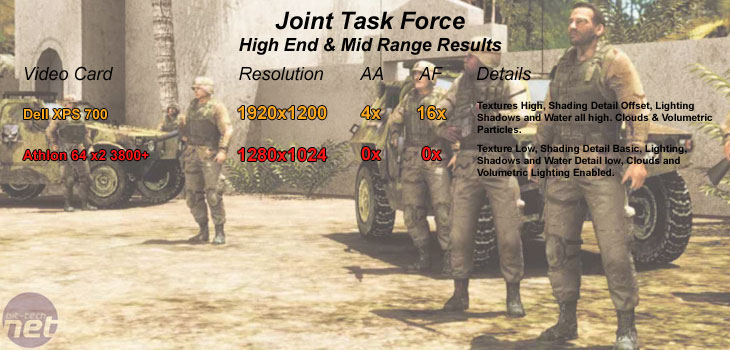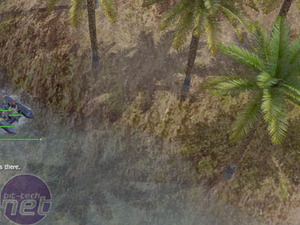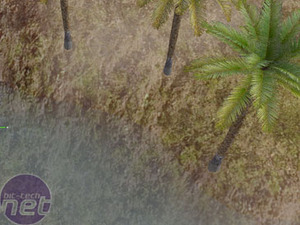We decided that to benchmark the game, and gauge how much difference the hardware will make to the graphics we would test it against a mid-range system and a high end system. The difference we found was pretty drastic:
Intel Core 2 Duo E6700 (10x267 - 2670MHz); nForce 590 SLI Intel Edition BTX mobo; 2 x 1GB DDR2 memory (operating in dual channel at 667MHz with 5-5-5-16 timings); NVIDIA GeForce 7900 GTX (operating at 650/1600MHz); 2x Western Digital 2500JS 250GB SATA 3Gbps hard drives in RAID 0; Creative X-Fi Extreme Music; Windows XP Service Pack 2; DirectX 9.0c/
 The game looks breath taking on the Dell XPS 700, with everything maxed out the game still runs smoothly and despite the high resolution I was able to maintain an average of 20 fps though the tougher areas of the game, and the frame rate was well over 30 frames per second in other less-intensive areas. Click below to see an in game screenshot with everything turned up to full.
The game looks breath taking on the Dell XPS 700, with everything maxed out the game still runs smoothly and despite the high resolution I was able to maintain an average of 20 fps though the tougher areas of the game, and the frame rate was well over 30 frames per second in other less-intensive areas. Click below to see an in game screenshot with everything turned up to full.
The other end of the scale isn't quite so bright though as I found I had to knock a lot of the graphical features right down to make the game playable. Without anti-aliasing the in game environment looks very jagged and aliased (as one would expect) - we would say that the game really benefits from some anti-aliasing, so enable it if you can. The game is still playable on a resonably old system, so if your not a graphical purist don't get too hung up if you only just meet the minimum specifications. Click below to see an in game screenshot with everything turned off.
The same can be said for shading and lighting, with changes to both effects making a minimal difference. Craters look slightly better with shading increased, although the fact they dissapear after a short while gives you the feeling they have been stuck on. Water on the other hands look superb on the highest setting, flowing freely and splashing and rippling when your troops interact with it. On lower settings the water doesn't seem to move much and looks far less realistic - once again though screenshots don't display this particularly well.
One area that we did see a major difference was when shadows were turned on and off. Due to this being a game normally viewed from a top down angle, shadows are fundamental as they make the images come to life. As you can see in the image below with shadows turned off the trees project no dark outline, the game contains lots of buildings, tanks and trees that would all be more than dissatisifed if denied the option to cast a shadow. Make sure you turn shadows on.


Mid-Range System
AMD Athlon 64 X2 3800+ (10x200 - 2000MHz); Shuttle SN25P (nForce4); 2 x 512MB Corsair (operating in dual channel at 400MHz with 2-2-2-5 timings); NVIDIA GeForce 6800 GT (350/1000MHz); Seagate Barracuda 7200.9 200GB 7,200RPM SATA 3Gbps hard disk drive; AC'97 on-board sound; Windows XP Professional Service Pack 2; DirectX 9.0c.High-End System
We chose the meaty £2500 Dell XPS 700 (the behemoth of our labs) to test as our high end system. Check out our Dell XPS 700 review to find out the full details.Intel Core 2 Duo E6700 (10x267 - 2670MHz); nForce 590 SLI Intel Edition BTX mobo; 2 x 1GB DDR2 memory (operating in dual channel at 667MHz with 5-5-5-16 timings); NVIDIA GeForce 7900 GTX (operating at 650/1600MHz); 2x Western Digital 2500JS 250GB SATA 3Gbps hard drives in RAID 0; Creative X-Fi Extreme Music; Windows XP Service Pack 2; DirectX 9.0c/

The other end of the scale isn't quite so bright though as I found I had to knock a lot of the graphical features right down to make the game playable. Without anti-aliasing the in game environment looks very jagged and aliased (as one would expect) - we would say that the game really benefits from some anti-aliasing, so enable it if you can. The game is still playable on a resonably old system, so if your not a graphical purist don't get too hung up if you only just meet the minimum specifications. Click below to see an in game screenshot with everything turned off.
Graphical Options
We had a closer look at the graphical tinkerings you can make. Due to this game being an RTS most of the graphical tweaks make a minimal difference to the screenshots because most of your viewing taken from quite a distance away from the action. Pushing textures to low for example makes a small difference which, although does make an impression when viewing the game over a long period of time, has a minimal effect in comparative screenshots.The same can be said for shading and lighting, with changes to both effects making a minimal difference. Craters look slightly better with shading increased, although the fact they dissapear after a short while gives you the feeling they have been stuck on. Water on the other hands look superb on the highest setting, flowing freely and splashing and rippling when your troops interact with it. On lower settings the water doesn't seem to move much and looks far less realistic - once again though screenshots don't display this particularly well.
One area that we did see a major difference was when shadows were turned on and off. Due to this being a game normally viewed from a top down angle, shadows are fundamental as they make the images come to life. As you can see in the image below with shadows turned off the trees project no dark outline, the game contains lots of buildings, tanks and trees that would all be more than dissatisifed if denied the option to cast a shadow. Make sure you turn shadows on.



MSI MPG Velox 100R Chassis Review
October 14 2021 | 15:04












Want to comment? Please log in.